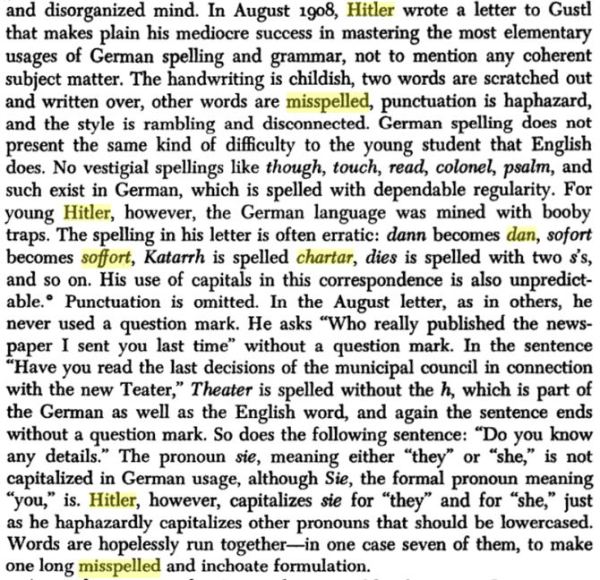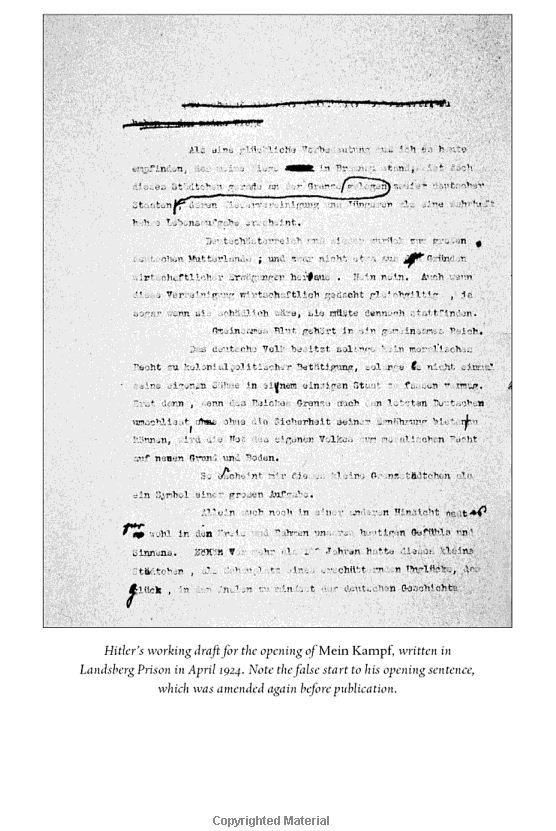The painfully flawed writings of Adolf Hitler
The anti-woman, homo-phobic, and anti-Semitic writings of Hitler are painfully flawed and rather empty in their ideas and content. Nonetheless, those who study how he tried to write, to spell, and to type note that Hitler was an embarrassment to German education.
Here, for example, are notes from Timothy W. Ryback, from pages 71-73 of his research, Hitler’s Private Library: The Books That Shaped His Life:
When Hitler boasted of his education at state expense, he not only flaunted his disdain for the Bavarian penal system but also exposed his meager understanding of serious education, a fact that is revealed in Mein Kampf both in terms of its vacuous intellectual content and its painfully flawed grammar. In the surviving bits of unpublished Hitler texts I found in archives across Europe and America, [Hitler] the collector-cum-author emerges as a half-educated man who has mastered neither basic spelling nor common grammar. His raw texts are riddled with lexical and syntactical errors. At age thirty-five, Hilter had not even mastered basic spelling. He writes “es gibt” — “there is” — phonetically rather than grammatically as “es giebt.” But the remnant pieces I studied, including Hitler’s original draft for the first chapter of Mein Kampf, as well as an eighteen-page outline to five subsequent chapters, demonstrate he took his writing seriously.
It has long been assumed that Hitler dictated Mein Kampf to his fellow prisoners, in particular his personal secretary, Rudolf Hess, and his chauffeur and bodyguard, Emil Maurice. In fact, Hitler had begun work on his manuscript before either one of them arrived in Landsberg. This first draft, typed in Pica with faded blue ribbon, shows a fitful start to the four-hundred-page book that was to follow. A single line is typed across the top of the untitled page, “It is not by chance that my cradle,” then breaks off, drops two carriage returns, and begins anew. “It must be seen in my opinion as a positive omen that my cradle stood in Braunau since this small town lies directly on the boarder of two German states whose reunification we young people see as a higher goal in life,” Hitler writes with an evidently measured cadence, though he misspells higher — hohre rather than höhere — before pulling two more carriage returns and plunging into an emphatic claim that this reunification is driven not be economic considerations — “Nein! Nein! he hammers — but by the common bond of blood. “Gemeinsames Blut gehört in ein gemeinsames Reich!” he writes. “Common blood belongs in a common empire.”
At some point in the opening paragraphs, Hitler paused, took a blue pencil, and went back to make amendments, striking out his first failed sentence, making one grammatical correction, but overlooking several others.
And here’s the last page of Hitler’s first letter, now “on permanent display at the Museum of Tolerance in Los Angeles”:

An anonymous commenter, so upset by the sloppiness of the Gemlich letter, which we all can see now, visited my blog Aristotle’s Feminist Subject today, and registered this complaint:
I am German and all I can say is, that this letter contains many errors, orthographic mistakes and even the signature has some very strange errors. The letter is typewritten, which is very strange. In 1919, Hitler was a young man and attested poor. To own a typewriter was luxury !
Space error, a lot of comma faults, use of smal and large words, the word UND in the beginning which is absolute not German style, the word UND after an comma which is absolute no German style, one sentence makes absolute NO sense and is too too long, the word Führernsicher does NOT exist in German language, sentences which are NOT German, but foreign script and style, some words to end a sentence are just missed !the writer was 100 % not a German and even misspelled the word Pogrom !!, and last but not least: The continental typewriter already had a German “ß”, “ä” and “ü”, but the writer of the letter didn´t use theese letters. My opinion as long time militariy collector. THIS letter is 100% FAKE !
While grateful for the careful attention to the painfully flawed writing in the letter, I was reminded that this is how Hitler actually cruelly butchered the German language. Alas, reading what Hitler wrote is always a terrible reminder of the pains of his pen, the wreck of his typewriter, and the horrors of his Reich.
—
Here are just a few more examples from Eugene Davidson’s, The Making of Adolf Hitler: The Birth and Rise of Nazism:




Another example of ignorance breeding contempt (in so many ways). Thank you for sharing… well-written and thought-provoking.
New York Times article on the letter:
Another example of ignorance breeding contempt (in so many ways).
Well put, jezibelle!
Notice how Hitler misspells “Pogrom” on the first page of his letter to Adolf Gemlich:
In English translation, that misspelling of “pogroms” comes out this way:
Below, reviewing the significance of this letter, is a transcript of a video released by the Museum of Tolerance:
Rabbi Hier also says (in the MOT online announcement of the exhibit):
as the previous german commentor said—-this is a fake letter—-someone made a lot of money pretending it was hitlers—-theres a fool born every minute.
Dear Susan Veres,
You are right to suspect that money may motivate a forgery. Nonetheless, the Simon Wiesenthal Center director and trustees and researchers have been careful to scrutinize the Gemlich letter publicly, investigating not only the secondary literature and other historical artifacts around it but also using the best forsensics on the document itself.
And I hope all can see that Timothy W. Ryback, working on many more works of Hitler than just the Gemlich letter shows how Hitler was a very poor writer of the German language. His sloppiness with spelling and with typing is shown to be consistently worse than that of forgerers.